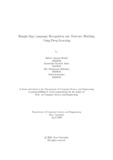| dc.contributor.advisor | Alam, Md. Ashraful | |
| dc.contributor.author | Shurid, Safayet Anowar | |
| dc.contributor.author | Amin, Khandaker Habibul | |
| dc.contributor.author | Mirbahar, Md. Shahnawaz | |
| dc.contributor.author | Karmaker, Dolan | |
| dc.date.accessioned | 2021-05-30T06:21:24Z | |
| dc.date.available | 2021-05-30T06:21:24Z | |
| dc.date.copyright | 2020 | |
| dc.date.issued | 2020-04 | |
| dc.identifier.other | ID: 16101030 | |
| dc.identifier.other | ID: 16101093 | |
| dc.identifier.other | ID: 16101025 | |
| dc.identifier.other | ID: 16101058 | |
| dc.identifier.uri | http://dspace.bracu.ac.bd/xmlui/handle/10361/14455 | |
| dc.description | This thesis is submitted in partial fulfillment of the requirements for the degree of Bachelor of Science in Computer Science and Engineering, 2020. | en_US |
| dc.description | Cataloged from PDF version of thesis. | |
| dc.description | Includes bibliographical references (pages 44-45). | |
| dc.description.abstract | Modern age being the era of Information technology, it would not have come this
far without the piled up data or information. Whereas communication is the basis
of collecting or gathering data or information, almost 5% of the world’s population
is not blessed with the ability of verbal communication [1]. For deaf and dumb
people lacking the ability of verbal communication, sign language is the solution.
Sign language varies from the verbal language in every form and rule. This creates a
gap between people conversing in verbal language and those communicating in sign
language. Verbal languages are easy to interpret for having a common rule-following
but sign language differs from region to region. This hampers the communication
between normal people and those interacting in sign languages. Human to human
interpretation is tough because of the enriched word wise signs and vocabs. To
eradicate this issue, we are proposing a machine-based approach for training and
detecting the Bangla Sign Language. Our aim is to train the system with enough
samples containing different signs used in Bangla Sign Language. In this research,
we are using the Convolutional Neural Network (CNN) for training each individual
sign. In addition to working as a medium of communication between the deaf and
mute with the remaining society, this approach would also serve as a tool for the
hearing deprived to learn and use the sign language properly. Moreover, this would
also come to assistance for anyone willing to learn or develop sign language or wishes
to work with those with special needs of using sign language. | en_US |
| dc.description.statementofresponsibility | Safayet Anowar Shurid | |
| dc.description.statementofresponsibility | Khandaker Habibul Amin | |
| dc.description.statementofresponsibility | Md. Shahnawaz Mirbahar | |
| dc.description.statementofresponsibility | Dolan Karmaker | |
| dc.format.extent | 45 pages | |
| dc.language.iso | en_US | en_US |
| dc.publisher | Brac University | en_US |
| dc.rights | Brac University theses are protected by copyright. They may be viewed from this source for any purpose, but reproduction or distribution in any format is prohibited without written permission. | |
| dc.subject | Communication | en_US |
| dc.subject | Sign Language | en_US |
| dc.subject | Bangla Sign Language | en_US |
| dc.subject | Deaf and mute | en_US |
| dc.subject | Convolutional Neural Network | en_US |
| dc.title | Bangla sign language recognition and sentence building using deep learning | en_US |
| dc.type | Thesis | en_US |
| dc.contributor.department | Department of Computer Science and Engineering, Brac University | |
| dc.description.degree | B. Computer Science | |

